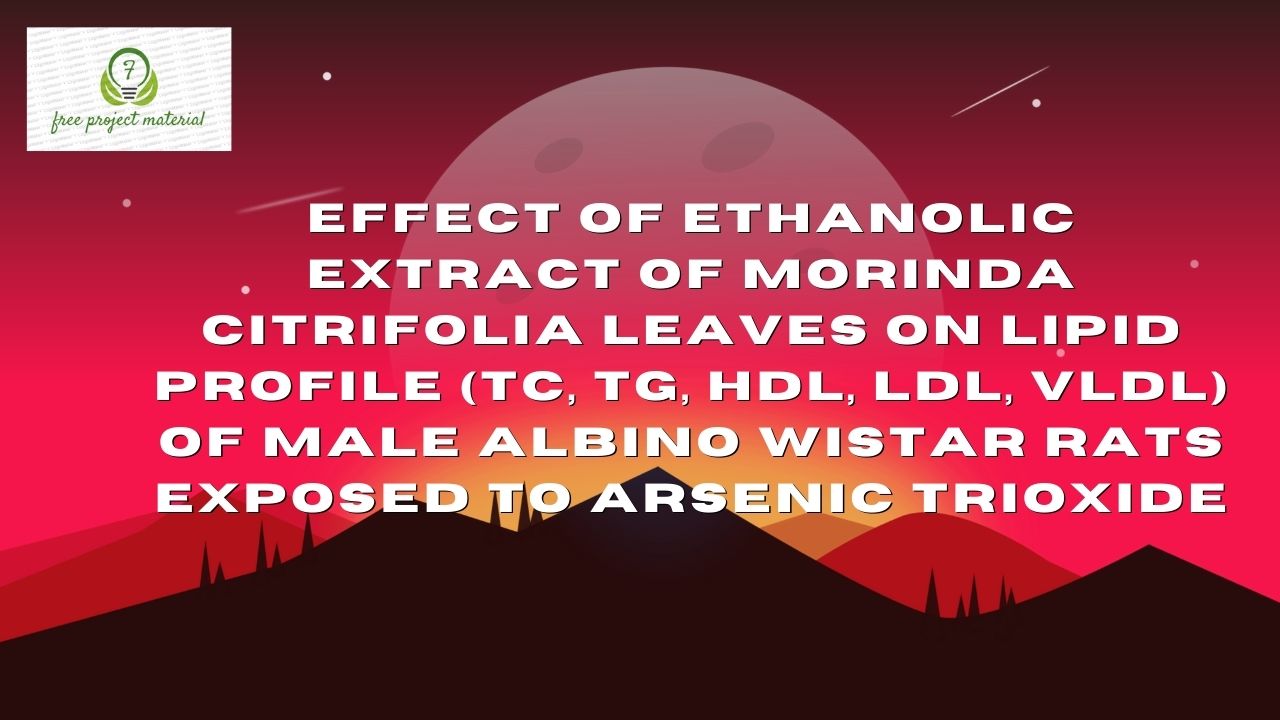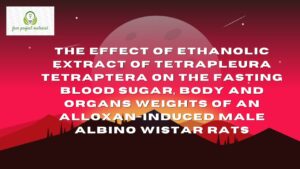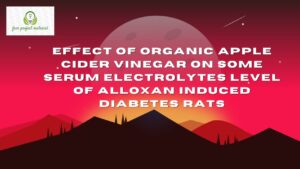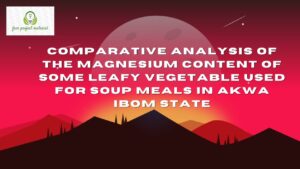ABSTRACT
The aim of this study was to examine the effect of ethanolic extract of the leaves of Morinda citrifolia on the lipid profile of albino wistar rats exposed to arsenic trioxide. The animals were randomly assigned has five (5) groups of four (4) rats each. Groups 1 served as the normal control, which was given only normal rat chow and distilled water, group 2 served as the negative control and was treated with 25% of LD50 of arsenic trioxide which was 3.65kg, normal rat feed and distilled water, group 3, 4 and 5 were given 25% of LD50 of arsenic trioxide and 100 mg/kg body weight, 200 mg/kg bodyweight and 300 mg/kg of the Ethanolic leaves extract of Morinda citrifolia with concomitant exposure to arsenic trioxide, Normal rat chow and distilled water. The results of the serum analysis of the lipid profile revealed. A significant increase (P<0.05) in the level of TC, TG, VDL, VLDL with a significant decrease in HDL which were reversed on co-administration of the ethanolic leaves extract of Morinda citrifolia. This result suggest that the leaves extract possess strong hypolipidemic activity. Therefore, its used as hypolipidemic and management of cardiovascular disease is recommended.
Keywords: Morinda citrifolia, Arsenic trioxide, Lipid Profile, Therapeutic.
TABLE OF CONTENT
TITLE PAGE – – – – – – – – i
CERTIFICATION – – – – – – – – ii
DEDICATION – – – – – – – – iii
ACKNOWLEDGMENT – – – – – – – iv
ABSTRACT – – – – – – – – v
TABLE OF CONTENTS – – – – – – vi
List of Plate – – – – – – – – – ix
List of Table – – – – – – – – x
CHAPTER ONE: INTRODUCTION
1.1 Background of the study – – – – – – 1
1.2 Aim and Objectives of the Study – – – – – 4
1.2.1 Aim of the Study – – – – – – – 4
1.2.2 Objectives of the Study – – – – – – 4
1.3 Significance of the Study – – – – – – 5
1.4 Scope and Limitations of the Study – – – – 5
1.5 Definition of Terms – – – – – – – 6
1.6 Abbreviations – – – – – – – – 8
CHAPTER TWO: LITERATURE REVIEW
2.1 Botanical Classification of Morinda citrifolia – – – 9
2.2 Description and Distribution of Morinda citrifolia – – 11
2.3 Nutritional Value of Morinda citrifolia – – – – 14
2.4 Ethnomedicinal Use of Morinda citrifolia – – – 16
2.5 Phytochemical of the Plant – – – – – – 18
2.6 Pharmacological Activities of the Plant – – – – 20
2.7 Heavy metals and their Toxicity – – – – – 22
2.7.1 Arsenic Trioxide – – – – – – – 25
2.8 Abortion and Distribution of Arsenic in the body – – 26
2.9 Medicinal use of Arsenic trioxide – – – – – 28
2.10 Mechanism of Arsenic Toxicity – – – – – 28
2.11 Toxicity of Arsenic Trioxide – – – – – 29
2.12 Clinical implications of Arsenic Trioxide – – – 31
2.13 Treatment of Arsenic Toxicity – – – – – 32
2.14 Lipid Profile – – – – – – – – 34
2.14.1 Total Cholesterol – – – – – – – 36
2.14.2 Triglycerides – – – – – – – 38
2.14.3 High-density Lipoprotein – – – – 39
2.14.4 Low-density Lipoprotein – – – – – – 41
2.14.5 Very Low-Density Lipoprotein – – – – – 42
2.15 Review of Related Work – – – – – – 44
CHAPTER THREE: METHODOLOGY
3.1 Material and Regents – – – – – – – 45
3.2. Collection and Preparation of Leaf Sample – – 47
3.2.1 Collection of Leaf Sample – – – – 47
3.2.2 Preparation of leaf sample – – – – 47
3.2.3 Preparation of Heavy Metal – – – – 48
3.3 Experimental Design, Grouping and
Treatment of Animals – – – – – 48
3.4 Collection of Blood Sample and Preservation of Serum – 50
3.5 Analysis of Lipids Profiles – – – – – 51
3.5.1 Analysis of Total Cholesterol (TC) – – – 51
3.5.2 Analysis of High-Density Lipoprotein (HDL) – – 52
3.5.3 Analysis of Triacylglycerol (TG) – – – 53
3.5.4 Analysis of Low-density Lipoprotein (LDL) – – 55
3.5.5 Analysis of Very Low-density lipoprotein (VLDL) – 55
3.6 Statistical Analysis – – – – – – 55
CHAPTER FOUR: RESULTS AND DISCUSSIONS
4.1 Morphology and Physiology of the Rats – – – 56
4.2 Results – – – – – – – – 57
4.3 Discussions – – – – – – – 59
CHAPTER FIVE: CONCLUSION AND RECOMMENDATIONS
5.1 Conclusion – – – – – – – 66
5.2 Recommendations – – – – – – 67
References
LIST OF PLATES
Plate 1: Morinda citrifolia plant – – – – – – – 10
LIST OF TABLES
Table I: Result of lipid profile – – – – – – – -` 57
CHAPTER ONE: INTRODUCTION
1.1 Background of Study
Traditional medicine is practiced worldwide either as the basis of health care or as any medicine are mainstay in most countries worldwide. The increasing demand for its services underscores the importance of traditional and complementary medicine as part of healthcare. Herbal medicine is a widespread and important form of traditional and complementary medicine used since ancient times. The world health organization (WHO) defines the herbal medicinal plants or products as those containing “herbs, herbal material, herbal preparation and finished herbal products containing as active ingredients parts of plants, other herbal material or combinations thereof (World health organization, 2019).
The use of herbal medicines and interest in this branch of traditional medicine to grow in both developing and developed countries. Herbal medicines and remedies are used either as a treatment or an adjunct/alternative therapy for a variety of acute and chronic conditions, including infertility and other reproductive disorders. Usage of qualified references guidelines, great manufacturing practices and administrative necessities contributes incredibly in creating herbal drugs of standardized quality. The clinical suggestions of sedate intuitive due to co-administration of customary and home-grown drugs in andrology are characterize, prove from clinical trials performed utilizing convention herbs, specifically, these are few plants with medicinal benefits; E. Longifolia also known as Longjack plants, is a flowering plant in the family Simaroubaceae, it is native to Indochina and Indonesia, but has also been found in Philippines. The plant is medium sized slender shrub that can reach 10m in height and is often unbranched. Another plant is Maca plant, scientifically named Lepidium meyenii, is an edible herbaceous biennial plant of the family Brassicaceae that is native of South America in the high Andes mountains of Peru. It was found excessively at the Mesote de Bombon plateau close to lake Junin in the late 1980. It packs high level of iron and iodine to promote healthy cells to helps keep metabolism on track. Ashwagandha plant, known commonly as winter cherry, is an evergreen shrub in the Solanaceae or nightshade family that grows in India, the middle east and parts of Africa, scientifically called Withania Somnifera, It contains chemicals that helps calm the brain, reduce swelling, lower blood pressure and alter the immune system. Fenugreek plants is an annual plant in the fabaceae, with leaves consisting of three small obovate to oblong leaflets. It is cultivated worldwide as a semiarid crop. It seeds and leaves are commonly ingredients in dishes from the Indian subcontinent and have been used as a culinary ingredient since ancient times. Trigonella Foenum – graccum is its scientific name, it helps in the lowering of blood sugar levels, boosting testosterone and increasing milk production in breast feeding mothers (Kenkal and Agarvial, 2020). To sum up, Morinda citrifolia also known as Noni plant is a fruit bearing tree in the coffee family of the Rubiaceae. Considered commonly as a traditional medicine that serves many health purposes (Pieroni and Andrea, 2005).
1.2 Aim and Objectives of the Study
1.2.1 Aim of the Study
This study aims to determine the effect of an ethanolic extract of Morinda citrifolia leaves on the lipid profile (TC, HDL, TG, LDL, VLDL) of the male albino wistar rats exposed to arsenic trioxide, an inorganic arsenic compound, and to find a remedy to promote or endorse the use of Morinda citrifolia as a medicinal herb for global pharmaceutical, food products, agricultural products and personal care products.
1.2.2 Objective of the Study
- To study the lipid profiles of the male albino wistar rats expose and non expose to arsenic trioxide.
- To examine the effect of heavy metal (Arsenic trioxide) on the lipid profiles (TC, TG, HDL, LDL and VLDL) of male albino wistar rats.
- Establishing a relationship on the chelating effects of ethanoic extract of Morinda citrifolia leaves on the lipid profiles of the male albino rats exposed to arsenic toxicity.
- Provision of references materials for further academic research on the effect of ethanoic extract of Morinda citrifolia on the lipid profiles of male albino wistar rats exposed to arsenic poisoning.
- Confirmation of the potency of Morinda citrifolia in the treatment of cadmium chloride toxicity.
1.3 Significance of the Study
This research work will be useful to medical doses, pharmacist and herbalist etc. in verifying believes obtained from Folklore medicine on the effect of Morinda citrifolia on arsenic trioxide (heavy metal) poisoning.
The result will also be useful to other researchers in giving directives and providing focus on the effect of ethanoic extract of Morinda citrifolia the lipid profiles of male albino rats exposed to heavy metals.
1.4 Scope and Limitations of the Study
This Study Covers solely on the effect of ethanoic extract of Morinda citrifolia leaves on Lipid profile (TC, TG, HDL, LDL, VLDL) of male albino wistar exposed to an Inorganic arsenic compound, Arsenic trioxide (As2O3)
However, the limitation of the study includes the time frame which was given to this research, lack of sophisticated equipment and poor financial support obtained in carrying out the research work.
1.5 Definition of Terms
- Morinda citrifolia L. (Rubiaceae) leaf or Noni leaf, is a medicinal food (ulam) used in traditional medicine to prevent chronic diseases, it also has to potential to be formulated into a fictional antiatherosclerotic agent.
- Heavy metal is defined as metallic elements that have a relatively high density compared to water with the assumption that heaviness and toxicity are inter-related, heavy metals also include metalloid, suck as arsenic, that are able to induce toxicity at low level of exposure.
- Arsenic trioxide is an inorganic compound and medication, as an industrial, whose major uses include in the manufacture of wood preservative, pesticides, and glass. As a medication, it is used to treat a type of cancer known as Acute promyelocytic leukemia (APL).
- Extract is a preparation containing the active ingredients of a substance in a concentrated form.
- Lipid profiles is a blood tests used to abnormalities in lipids, such as cholesterol and triglycerides.
- Ethanoic extract is a process used in raw products distillation. It is done soaking raw substances in ethanol to pull out a solvent and the extract is then removed. The ethanol extraction process is used to filter out raw material contents from extracted material.
1.6 Abbreviations
AS2O3– Arsenic trioxide
APL-Acute Promyelocytic leukemia
MMA – Mono-methylarsonic acid
DMA – Dimethylarsinic acid
HDL – High density lipoprotein
TG – Triglcholesterol
TC – Total cholesterol
LDL – Low-density lipoprotein
VLDL – Very-low-density Lipoprotein
NM – N-methyl-n-nitrosourea
CCA – copper chromated arsenic
GI – Gastrointestinal tract
ATRA – Arsenic trioxide with all-trans retinoic acid.



